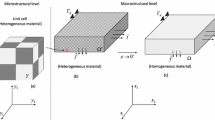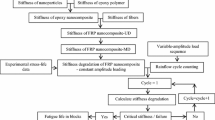Abstract
A hyperelastic–viscoplastic constitutive model is developed to describe the strain-softening behavior of glass-filler-reinforced–epoxy composites under large strain-compression loading. The model’s rheological network comprises two parallel networks; the first consists of a nonlinear elastic spring in series with a nonlinear viscous dashpot, and the other involves a hyperelastic Langevin spring. The postyield strain softening in the model is introduced by a time-dependent shear resistance to molecular deformation, where the shear resistance is varied from an initial value up to a saturation value at large strain. The model is reduced to a one-dimensional incompressible case, and fitted to the experimental data of spherical- and milled-glass-fiber–epoxy composites to retrieve the optimized model parameters. Milled-fiber–epoxy composites exhibit higher values of optimized elastic modulus and shear deformation resistance parameters, which are correlated to outcomes of dynamic mechanical analyses like filler-reinforcement efficiency, polymer chain-entanglement density, and filler–matrix adhesion. The improvement in filler-reinforcement efficiency due to milled fibers leads to better load transmission to the matrix, resulting in enhanced elastic modulus of milled-fiber–epoxy composites. An increase in polymer chain-entanglement density and filler–matrix adhesion results in higher resistance to viscous flow for milled-fiber composites. Semiempirical equations for elastic modulus and shear-deformation resistance parameters are proposed that consider the relative stiffness of filler and matrix, and the shape and volume fraction of fillers. When the fillers are embedded in the polymer matrix, these equations operate as multiplicative factors to the neat polymers. Thus, the model is capable of capturing the stress–strain response of both neat polymer and glass-filled polymer composites.





Similar content being viewed by others
References
Acar, A., Colak, O., Correia, J.P.M., Ahzi, S.: Cooperative-VBO model for polymer/graphene nanocomposites. Mech. Mater. 125, 1–13 (2018). https://doi.org/10.1016/j.mechmat.2018.06.005
Affdl, J.H., Kardos, J.L.: The Halpin-Tsai equations: a review. Polym. Eng. Sci. 16(5), 344–352 (1976). https://doi.org/10.1002/pen.760160512
Alasfar, R.H., Ahzi, S., Barth, N., et al.: A review on the modeling of the elastic modulus and yield stress of polymers and polymer nanocomposites: effect of temperature, loading rate and porosity. Polymers 14(3), 360 (2022). https://doi.org/10.3390/polym14030360
Ali, S.F., Fan, J.: Elastic-viscoplastic constitutive model for capturing the mechanical response of polymer composite at various strain rates. J. Mater. Sci. Technol. 57, 12–17 (2020). https://doi.org/10.1016/j.jmst.2020.05.013
Anand, L., Ames, N.M., Srivastava, V., et al.: A thermo-mechanically coupled theory for large deformations of amorphous polymers. Part I: formulation. Int. J. Plast. 25(8), 1474–1494 (2009). https://doi.org/10.1016/j.ijplas.2008.11.004
Arash, B., Exner, W., Rolfes, R.: Effect of moisture on the nonlinear viscoelastic fracture behavior of polymer nanocomposites: a finite deformation phase-field model. Eng. Comput. (2022). https://doi.org/10.1007/s00366-022-01670-1
Argon, A.S.: A theory for the low-temperature plastic deformation of glassy polymers. Philos. Mag. 28(4), 839–865 (1973). https://doi.org/10.1080/14786437308220987
Arruda, E.M., Boyce, M.C.: A three-dimensional constitutive model for the large stretch behavior of rubber elastic materials. J. Mech. Phys. Solids 41(2), 389–412 (1993a). https://doi.org/10.1016/0022-5096(93)90013-6
Arruda, E.M., Boyce, M.C.: Evolution of plastic anisotropy in amorphous polymers during finite straining. Int. J. Plast. 9(6), 697–720 (1993b). https://doi.org/10.1016/0749-6419(93)90034-N
Bergstrom, J.S.: Mechanics of Solid Polymers: Theory and Computational Modeling. William Andrew, Elsevier, San Diego (2015)
Bergström, J.S., Boyce, M.C.: Constitutive modeling of the large strain time-dependent behavior of elastomers. J. Mech. Phys. Solids 46(5), 931–954 (1998). https://doi.org/10.1016/S0022-5096(97)00075-6
Boyce, M.C., Arruda, E.M.: An experimental and analytical investigation of the large strain compressive and tensile response of glassy polymers. Polym. Eng. Sci. 30(20), 1288–1298 (1990). https://doi.org/10.1002/pen.760302005
Boyce, M.C., Parks, D.M., Argon, A.S.: Large inelastic deformation of glassy polymers. Part I: rate dependent constitutive model. Mech. Mater. 7(1), 15–33 (1988). https://doi.org/10.1016/0167-6636(88)90003-8
Boyce, M.C., Weber, G.G., Parks, D.M.: On the kinematics of finite strain plasticity. J. Mech. Phys. Solids 37(5), 647–665 (1989). https://doi.org/10.1016/0022-5096(89)90033-1
De Vivo, B., Lamberti, P., Tucci, V., et al.: Comparison of the physical properties of epoxy-based composites filled with different types of carbon nanotubes for aeronautic applications. Adv. Polym. Technol. 31(3), 205–218 (2012). https://doi.org/10.1002/adv.21284
Faye, A., Parmeswaran, V., Basu, S.: Mechanics of dynamic fracture in notched polycarbonate. J. Mech. Phys. Solids 77, 43–60 (2015). https://doi.org/10.1016/j.jmps.2015.01.003
Ghoreishy, M.H.R., Firouzbakht, M., Naderi, G.: Parameter determination and experimental verification of Bergström–Boyce hysteresis model for rubber compounds reinforced by carbon black blends. Mater. Des. 53, 457–465 (2014). https://doi.org/10.1016/j.matdes.2013.07.040
Govaert, L.E., Timmermans, P.H.M., Brekelmans, W.A.M.: The influence of intrinsic strain softening on strain localization in polycarbonate: modeling and experimental validation. J. Eng. Mater. Technol. 122(2), 177–185 (2000). https://doi.org/10.1115/1.482784
Green, M.S., Tobolsky, A.V.: A new approach to the theory of relaxing polymeric media. J. Chem. Phys. 14(2), 80–92 (1946). https://doi.org/10.1063/1.1724109
Gurtin, M.E., Anand, L.: The decomposition F=FeFp, material symmetry, and plastic irrotationality for solids that are isotropic-viscoplastic or amorphous. Int. J. Plast. 21(9), 1686–1719 (2005). https://doi.org/10.1016/j.ijplas.2004.11.007
Hasan, O.A., Boyce, M.C.: Energy storage during inelastic deformation of glassy polymers. Polymer 34(24), 5085–5092 (1993). https://doi.org/10.1016/0032-3861(93)90252-6
Haward, R.N., Thackray, G.: The use of a mathematical model to describe isothermal stress-strain curves in glassy thermoplastics. Proc. R. Soc. Lond. Ser. A, Math. Phys. Sci. 302(1471), 453–472 (1968). https://doi.org/10.1098/rspa.1968.0029
Herbold, E.B., Nesterenko, V.F., Benson, D.J., et al.: Particle size effect on strength, failure, and shock behavior in polytetrafluoroethylene-Al-W granular composite materials. J. Appl. Phys. 104(10), 103903 (2008). https://doi.org/10.1063/1.3000631
Karunakaran, K., Singh, S.S., Kitey, R.: Investigating the role of filler shape on the dynamic mechanical properties of glass-filled epoxy composites. Polym. Compos. 43(10), 6912–6925 (2022). https://doi.org/10.1002/pc.26737
Kawaguchi, T., Pearson, R.A.: The effect of particle–matrix adhesion on the mechanical behavior of glass filled epoxies. Part 2. A study on fracture toughness. Polymer 44(15), 4239–4247 (2003). https://doi.org/10.1016/S0032-3861(03)00372-0
Khalil, H.A., Fizree, H.M., Bhat, A.H., et al.: Development and characterization of epoxy nanocomposites based on nano-structured oil palm ash. Composites, Part B, Eng. 53, 324–333 (2013). https://doi.org/10.1016/j.compositesb.2013.04.013
Li, Z., Lambros, J.: Strain rate effects on the thermomechanical behavior of polymers. Int. J. Solids Struct. 38(20), 3549–3562 (2001). https://doi.org/10.1016/S0020-7683(00)00223-7
Mallick, P.K., Broutman, L.J.: Mechanical and fracture behaviour of glass bead filled epoxy composites. Mater. Sci. Eng. 18(1), 63–73 (1975). https://doi.org/10.1016/0025-5416(75)90073-7
Mayr, A.E., Cook, W.D., Edward, G.H.: Yielding behaviour in model epoxy thermosets—I. Effect of strain rate and composition. Polymer 39(16), 3719–3724 (1998). https://doi.org/10.1016/S0032-3861(97)10334-2
Obaid, N., Kortschot, M.T., Sain, M.: Understanding the stress relaxation behavior of polymers reinforced with short elastic fibers. Materials 10(5), 472 (2017). https://doi.org/10.3390/ma10050472
Omar, M.F., Akil, H.M., Ahmad, Z.A.: Particle size–dependent on the static and dynamic compression properties of polypropylene/silica composites. Mater. Des. 45, 539–547 (2013). https://doi.org/10.1016/j.matdes.2012.09.026
Pleşa, I., Noţingher, P.V., Schlögl, S., et al.: Properties of polymer composites used in high-voltage applications. Polymers 8(5), 173 (2016). https://doi.org/10.3390/polym8050173
Raj, R., Dixit, A.R., Singh, S.S., Paul, S.: Print parameter optimization and mechanical deformation analysis of alumina-nanoparticle doped photocurable nanocomposites fabricated using vat-photopolymerization based additive technology. Addit. Manuf. (2022). https://doi.org/10.1016/j.addma.2022.103201
Ramakrishna, S., Mayer, J., Wintermantel, E., et al.: Biomedical applications of polymer-composite materials: a review. Compos. Sci. Technol. 61(9), 1189–1224 (2001). https://doi.org/10.1016/S0266-3538(00)00241-4
Ree, T., Eyring, H.: Theory of non-Newtonian flow. I. Solid plastic system. J. Appl. Phys. 26(7), 793–800 (1955). https://doi.org/10.1063/1.1722098
Rubino, F., Nisticò, A., Tucci, F., et al.: Marine application of fiber reinforced composites: a review. J. Mar. Sci. Eng. 8(1), 26 (2020). https://doi.org/10.3390/jmse8010026
Sain, T., Meaud, J., Yeom, B., et al.: Rate dependent finite strain constitutive modeling of polyurethane and polyurethane–clay nanocomposites. Int. J. Solids Struct. 54, 147–155 (2015). https://doi.org/10.1016/j.ijsolstr.2014.10.027
Sakib, M.N., Iqba, A.A.: Epoxy based nanocomposite material for automotive application-a short review. Int. J. Automot. Mech. Eng. 18(3), 9127–9140 (2021). https://doi.org/10.15282/ijame.18.3.2021.24.0701
Singh, S.S., Chakraborty, P., Kitey, R.: Deformation characteristics of glass-filled epoxy composite under compression: role of filler shape and volume fraction. Polym. Compos. 40(12), 4726–4741 (2019). https://doi.org/10.1002/pc.25341
Siviour, C.R., Jordan, J.L.: High strain rate mechanics of polymers: a review. J. Dyn. Behav. Mater. 2(1), 15–32 (2016)
Van Breemen, L.C., Engels, T.A., Klompen, E.T., et al.: Rate-and temperature-dependent strain softening in solid polymers. J. Polym. Sci., Part B, Polym. Phys. 50(24), 1757–1771 (2012). https://doi.org/10.1002/polb.23199
Van Melick, H.G.H., Govaert, L.E., Meijer, H.E.H.: Localisation phenomena in glassy polymers: influence of thermal and mechanical history. Polymer 44(12), 3579–3591 (2003). https://doi.org/10.1016/S0032-3861(03)00089-2
Zachariades, A.E., Porter, R.S. (eds.): The Strength and Stiffness of Polymers Marcel Dekker, Inc. (Plastics Engineering), New York (1983)
Acknowledgement
The financial support for this research was provided by the Indian Institute of Technology (Indian School of Mines) Dhanbad, India, through Faculty Research Scheme grant FRS(146)/2020-2021/MECH.
Author information
Authors and Affiliations
Contributions
1. Sudeepto Paul: Analysis and interpretation of data, manuscript preparation. 2. Sarthak S. Singh: Revising the manuscript critically for important intellectual content and final approval of the manuscript
Corresponding author
Ethics declarations
Competing interests
The authors declare no competing interests.
Additional information
Publisher’s Note
Springer Nature remains neutral with regard to jurisdictional claims in published maps and institutional affiliations.
Rights and permissions
Springer Nature or its licensor (e.g. a society or other partner) holds exclusive rights to this article under a publishing agreement with the author(s) or other rightsholder(s); author self-archiving of the accepted manuscript version of this article is solely governed by the terms of such publishing agreement and applicable law.
About this article
Cite this article
Paul, S., Singh, S.S. Modeling the strain-softening behavior of glass-filled epoxy composites using a hyperelastic–viscoplastic model. Mech Time-Depend Mater 27, 929–947 (2023). https://doi.org/10.1007/s11043-022-09574-9
Received:
Accepted:
Published:
Issue Date:
DOI: https://doi.org/10.1007/s11043-022-09574-9




